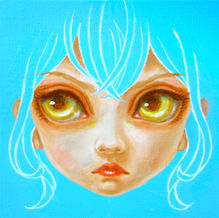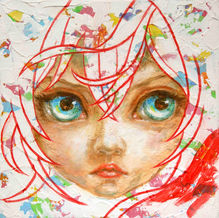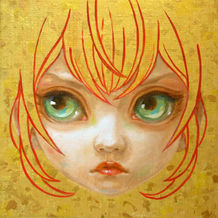top of page
Oil Painting 油彩
不思議世界に住む少女・不思議世界を旅する少女
存在
Existence

S0-014-BlW
油彩 アクリル キャンバス S0 2025年

S0-012-WR
油彩 アクリル キャンバス S0 2025年

S0-009-GoR
油彩 アクリル キャンバス S0 2025年
存在 2
Existence 2

スフィンクス
油彩 キャンバス S50 2017

瞳の海
油彩 キャンバス S30 2018

Pink Sphinx
油彩 キャンバス F15 2015
個人蔵
個人蔵
旅する生活
Travering Life

風は歌う
油彩 アクリル 雲母 砂 キャンバス S3 2024

空は歌う
油彩 アクリル 雲母 砂 キャンバス S3 2024

祈り
油彩 アクリル キャンバス F0 2024
旅をする森
Travering Woods

光の海へ
アクリル キャンバス F6 2024

終わらざりし物語
アクリル 雲母 砂 キャンバス SSM 2024

風の森
アクリル 雲母 砂 キャンバス SM 2024
幻想建築
Surreal Architecture

都市の記憶
油彩 アクリル キャンバス F0 2024

記憶の結晶
油彩 アクリル キャンバス F0 2024

水柱
油彩 アクリル キャンバス F0 2024
Oil Painting 油彩
日本伝統絵画×少女
浮世絵(版画)は、江戸時代に木版印刷技術を用いて大量生産され、庶民へも芸術を提供しました。日本の色彩、構図、デザインなどの面でも多くの革新的な要素を導入しました。
そして浮世絵は日本だけでなく、西洋の美術や文化に大きな影響を与えました。特にヨーロッパの印象派やポスト印象派の画家たちは、浮世絵からインスパイアを受け、その美術表現に取り入れました。
浮世絵は現代日本のマンガやアニメにも影響を与え、漠然と私たちの身近にあると言えるでしょう。その浮世絵の中に、少女を入れました。ご存じの浮世絵はありませんか?
日本伝統の構図やアウトラインも生かしつつ、写実的表現や現代絵具の金属色を加え、オリジナルで新鮮な表現を追究しました。

仮面
東洲斎写楽「大谷鬼次の江戸兵衛」
M10 油彩 アルキド樹脂絵具 キャンバス

仮面
東洲斎写楽「紀伊国屋納子
三代目沢村宗十郎の孔雀三郎なり平」
F3 油彩 アルキド樹脂絵具
キャンバス
キャンバス

仮面
東洲斎写楽「堺屋秀鶴 二代目中村仲蔵の小野の百姓田のくろのつち蔵 実は惟高親王」
F3 油彩 アルキド樹脂絵具
キャンバス
キャンバス

雷神 俵屋宗達・尾形光琳・酒井抱一《風神雷神図屏風》のオマージュ
F3 アクリル 蓄光塗料 キャンバス 個人蔵
《風神雷神図屏風》は江戸時代初期に俵屋宗達によって描かれました。
その後、尾形光琳・酒井抱一・鈴木其一という有名絵師たちが模写しつつ独自にアレンジするほど、興味深いテーマです。
《風神雷神図屏風》は江戸時代初期に俵屋宗達によって描かれました。
その後、尾形光琳・酒井抱一・鈴木其一という有名絵師たちが模写しつつ独自にアレンジするほど、興味深いテーマです。

風神 俵屋宗達・尾形光琳・酒井抱一《風神雷神図屏風》のオマージュ
F3 アクリル 蓄光塗料 キャンバス 個人蔵
《風神雷神図屏風》は江戸時代初期に俵屋宗達によって描かれました。
その後、尾形光琳・酒井抱一・鈴木其一という有名絵師たちが模写しつつ独自にアレンジするほど、興味深いテーマです。
《風神雷神図屏風》は江戸時代初期に俵屋宗達によって描かれました。
その後、尾形光琳・酒井抱一・鈴木其一という有名絵師たちが模写しつつ独自にアレンジするほど、興味深いテーマです。

《ヴィーナスの誕生》
葛飾北斎「神奈川沖浪裏(富嶽三十六景)」のオマージュ
油彩 アクリル アルキド樹脂絵具 ジェッソ キャンバス
葛飾北斎 神奈川沖浪裏 富嶽三十六景 ヴィーナス ビーナス ヴィーナスの誕生 ビーナスの誕生
葛飾北斎《神奈川沖浪裏》
浮世絵の傑作として世界ミニウム箔 キャンバス F6 2023的に知られ、世界と日本の美術史において非常に重要な位置を占めています。
大きな波が船や人々を巻き込む海上の緊迫した瞬間。巨大な波とその迫力を感じさせる構図や、風景の中での人々の小ささと脆弱さが強調されており、自然の力と人間の無力感が同時に表現されています。
その中で富士山は静かに佇む存在として描かれており、荒ぶる海と雲に囲まれながらもその存在感が際立っています。
《ヴィーナスの誕生》
【コンセプト】
ヴィーナスという愛と美の女神の誕生を、世界全体が寿いでいるというコンセプトの、めでたい作品です。
【少女=ヴィーナス=富士山】
少女に富士山のご祭神である木花咲耶姫(コノハナサクヤヒメ)を重ね、ヘアスタイルは日本風。流れる髪を富士山のシルエットにしました。
少女の瞳の虹彩にも金色を使っていますので、角度によってキラッと目が光ります。
「ヴィーナスの誕生」でよく知られているのは、ボッティチェッリの作品でしょう。私がヴィーナスのポーズの参考にしたのは、ブーシェの「ヴィーナス誕生」です。波の上に直接寝るという共通項で、カバネルの「ヴィーナス誕生」も念頭に浮かびました。
それらの影響を受けながらも、私はこの作品のヴィーナスを肉感的なポーズや姿態にはせず、芯のある精神的な存在としました。
【波】
北斎が描いた砕ける波頭は、現代のカメラで写したものと同じ形だそうです。私はそれを、ヴィーナスの誕生を寿ぐ花としました。筆やペインティングナイフのタッチが、動的に感じられることでしょう。
飛び散る水滴はアルミニウム箔で表現しています。アルミニウム箔は銀箔と違って変色しないため、ずっとキラキラと輝き続けます。
波の形は北斎を踏襲しつつ、油彩の半透明な青を塗り重ね、原画でしか感じられないような豊かな青となっています。
【空と雲】
北斎の作品は嵐の一場面なので、空は暗く、雲もものものしく感じられます。しかしこの作品はめでたい日ですので、空は柔らかな空色、雲は金色にしました。角度によって、光を反射します。見るたびに異なる色味に見えることでしょう。
葛飾北斎 神奈川沖浪裏 富嶽三十六景 ヴィーナス ビーナス ヴィーナスの誕生 ビーナスの誕生
葛飾北斎《神奈川沖浪裏》
浮世絵の傑作として世界ミニウム箔 キャンバス F6 2023的に知られ、世界と日本の美術史において非常に重要な位置を占めています。
大きな波が船や人々を巻き込む海上の緊迫した瞬間。巨大な波とその迫力を感じさせる構図や、風景の中での人々の小ささと脆弱さが強調されており、自然の力と人間の無力感が同時に表現されています。
その中で富士山は静かに佇む存在として描かれており、荒ぶる海と雲に囲まれながらもその存在感が際立っています。
《ヴィーナスの誕生》
【コンセプト】
ヴィーナスという愛と美の女神の誕生を、世界全体が寿いでいるというコンセプトの、めでたい作品です。
【少女=ヴィーナス=富士山】
少女に富士山のご祭神である木花咲耶姫(コノハナサクヤヒメ)を重ね、ヘアスタイルは日本風。流れる髪を富士山のシルエットにしました。
少女の瞳の虹彩にも金色を使っていますので、角度によってキラッと目が光ります。
「ヴィーナスの誕生」でよく知られているのは、ボッティチェッリの作品でしょう。私がヴィーナスのポーズの参考にしたのは、ブーシェの「ヴィーナス誕生」です。波の上に直接寝るという共通項で、カバネルの「ヴィーナス誕生」も念頭に浮かびました。
それらの影響を受けながらも、私はこの作品のヴィーナスを肉感的なポーズや姿態にはせず、芯のある精神的な存在としました。
【波】
北斎が描いた砕ける波頭は、現代のカメラで写したものと同じ形だそうです。私はそれを、ヴィーナスの誕生を寿ぐ花としました。筆やペインティングナイフのタッチが、動的に感じられることでしょう。
飛び散る水滴はアルミニウム箔で表現しています。アルミニウム箔は銀箔と違って変色しないため、ずっとキラキラと輝き続けます。
波の形は北斎を踏襲しつつ、油彩の半透明な青を塗り重ね、原画でしか感じられないような豊かな青となっています。
【空と雲】
北斎の作品は嵐の一場面なので、空は暗く、雲もものものしく感じられます。しかしこの作品はめでたい日ですので、空は柔らかな空色、雲は金色にしました。角度によって、光を反射します。見るたびに異なる色味に見えることでしょう。

《羽衣》
葛飾北斎「凱風快晴(富嶽三十六景)」または「赤富士」のオマージュ
能や民話でよく知られた「羽衣」の物語をオーバーラップさせました。
油彩 アクリル 金箔 アルミニウム箔 雲母 ガラスパウダー キャンバス
油彩 アクリル 金箔 アルミニウム箔 雲母 ガラスパウダー キャンバス

《愛は波のように》葛飾北斎《蛸と海女》のオマージュ
油彩 アクリル インク キャンバス F3 2021 個人蔵
“Shunga”としては、世界で最も知られているかもしれません。
二匹の蛸と海女さんが絡むという衝撃のシーンです。これは『喜能会之故真通(きのえのこまつ)』という物語の挿絵で、背景には官能小説が書かれています。きちんと読むと、ほとんどが生々しいオノマトペだそうです。
【コンセプト】
品位あるエロスの表現。日本的な抽象性を生かす。
【少女】
海女さんを立体的にしたことで、よりエロスを演出すると同時に、美しく品位を保ちました。髪は日本の様式美を取り入れ、流水紋です。
【蛸】
北斎の二匹の蛸に加え、三匹目が、大きな蛸の頭部にまるで分裂・増殖するように現れ、蛸の興奮を表しています。四匹目、五匹目……と、限りなく続くのかもしれません。
【背景】
北斎は海女さんを岩に寝そべらせていて、痛々しくも感じます。
私は岩を墨で抽象的に表現し波のようにも見せました。これはタイトルにあるように、歓喜が波のように何度も押し寄せて来るということを暗に示しています。
背景は三次元を感じさせない一面の金色で、蛸と海女さんが宙に浮いているようでもあります。ここからも歓喜の浮遊感を無意識に感じ取っていただけるでしょう。
“Shunga”としては、世界で最も知られているかもしれません。
二匹の蛸と海女さんが絡むという衝撃のシーンです。これは『喜能会之故真通(きのえのこまつ)』という物語の挿絵で、背景には官能小説が書かれています。きちんと読むと、ほとんどが生々しいオノマトペだそうです。
【コンセプト】
品位あるエロスの表現。日本的な抽象性を生かす。
【少女】
海女さんを立体的にしたことで、よりエロスを演出すると同時に、美しく品位を保ちました。髪は日本の様式美を取り入れ、流水紋です。
【蛸】
北斎の二匹の蛸に加え、三匹目が、大きな蛸の頭部にまるで分裂・増殖するように現れ、蛸の興奮を表しています。四匹目、五匹目……と、限りなく続くのかもしれません。
【背景】
北斎は海女さんを岩に寝そべらせていて、痛々しくも感じます。
私は岩を墨で抽象的に表現し波のようにも見せました。これはタイトルにあるように、歓喜が波のように何度も押し寄せて来るということを暗に示しています。
背景は三次元を感じさせない一面の金色で、蛸と海女さんが宙に浮いているようでもあります。ここからも歓喜の浮遊感を無意識に感じ取っていただけるでしょう。

《ピンク・ラブ》
喜多川歌麿
《歌まくら》第九図のオマージュ
油彩 アクリル モデリングペースト キャンバス
SM 2021年
喜多川歌麿
《歌まくら》
喜多川歌麿は、美人画で知られていますが、春画も描きました。
春画はその場面のシチュエーション――禁忌を犯すとか、身分のギャップなど――を楽しむものであるようです。例えば、この「歌まくら」という12枚のシリーズでは、役者とひいきのおかみさん、丁稚と店のおかみさん、花嫁と新郎ではない男性……などの組み合わせが見て取れます。共に描かれている小道具や場所が分かれば、より深い理解ができることでしょう。
この第九図では、醜い中年男が嫌がる乙女を無理に……というタブーが描かれています。
ミルヨウコ
《ピンク・ラブ》
【コンセプト】
原画の衝撃を残しながら、かわいらしさを演出する。
【ピンクの花熊】
歌麿の春画のむくつけき毛深い男を、ピンクの熊にしました。体に花が咲いていることがお茶目で、それで「場違いな感じ」を出しました。瞳には輝きがなく、穴が開いているようなところが怖いと思います。
【ウサギ耳髪の少女】
歌麿の原画の女性は抵抗しています。私も少女を応援し、抵抗させました。自然界では弱いウサギでも、噛みついて自分を貫こうとしています。
【背景】
背景はシルバーです。画面上の両角付近には、邪魔にならない程度にマチエールをつけました。シルバーの色はいぶし銀のようで、落ち着いたアンティークな風合いがあります。
SM 2021年
喜多川歌麿
《歌まくら》
喜多川歌麿は、美人画で知られていますが、春画も描きました。
春画はその場面のシチュエーション――禁忌を犯すとか、身分のギャップなど――を楽しむものであるようです。例えば、この「歌まくら」という12枚のシリーズでは、役者とひいきのおかみさん、丁稚と店のおかみさん、花嫁と新郎ではない男性……などの組み合わせが見て取れます。共に描かれている小道具や場所が分かれば、より深い理解ができることでしょう。
この第九図では、醜い中年男が嫌がる乙女を無理に……というタブーが描かれています。
ミルヨウコ
《ピンク・ラブ》
【コンセプト】
原画の衝撃を残しながら、かわいらしさを演出する。
【ピンクの花熊】
歌麿の春画のむくつけき毛深い男を、ピンクの熊にしました。体に花が咲いていることがお茶目で、それで「場違いな感じ」を出しました。瞳には輝きがなく、穴が開いているようなところが怖いと思います。
【ウサギ耳髪の少女】
歌麿の原画の女性は抵抗しています。私も少女を応援し、抵抗させました。自然界では弱いウサギでも、噛みついて自分を貫こうとしています。
【背景】
背景はシルバーです。画面上の両角付近には、邪魔にならない程度にマチエールをつけました。シルバーの色はいぶし銀のようで、落ち着いたアンティークな風合いがあります。

道行
狩野永徳「唐獅子」のオマージュ
F3 油彩 アクリル キャンバス 2024年

《天界の音楽》
歌川豊国《中村歌六》のオマージュ
油彩 アルキド樹脂絵具 キャンバス
F3 2023年
歌川豊国
《中村歌六》
原画は歌舞伎の一場面らしく、「中村歌六」とあります。弁財天が黒雲の沸き立つ中、龍に乗り、琴を弾いています。弁財天といえば琵琶のイメージですが、琴なのが珍しく思いました。
「豊国」とありますが、何代目の豊国かははっきりしません。
弁財天は布をたっぷり使った、豪華な中国風の衣装を身に付けています。
ミルヨウコ
《天界の音楽》
【コンセプト】
音楽が聞こえて来そうな華麗な作品。
【少女】
原画で琴を弾いているのは、弁財天です。それを少女にしました。弁財天は斜め横を向いていますが、私は少女をほとんど正面向きにし、キリリとした目元にしました。
【龍】
グリーンとオレンジという補色で生き生きと表現しました。
【雲】
原画でも雲は日本の古典的な雲模様の様式で表現されています。それを踏襲しましたが、輪郭線はシルバーで、クールさと煌めく華麗さを加えました。
F3 2023年
歌川豊国
《中村歌六》
原画は歌舞伎の一場面らしく、「中村歌六」とあります。弁財天が黒雲の沸き立つ中、龍に乗り、琴を弾いています。弁財天といえば琵琶のイメージですが、琴なのが珍しく思いました。
「豊国」とありますが、何代目の豊国かははっきりしません。
弁財天は布をたっぷり使った、豪華な中国風の衣装を身に付けています。
ミルヨウコ
《天界の音楽》
【コンセプト】
音楽が聞こえて来そうな華麗な作品。
【少女】
原画で琴を弾いているのは、弁財天です。それを少女にしました。弁財天は斜め横を向いていますが、私は少女をほとんど正面向きにし、キリリとした目元にしました。
【龍】
グリーンとオレンジという補色で生き生きと表現しました。
【雲】
原画でも雲は日本の古典的な雲模様の様式で表現されています。それを踏襲しましたが、輪郭線はシルバーで、クールさと煌めく華麗さを加えました。
bottom of page







